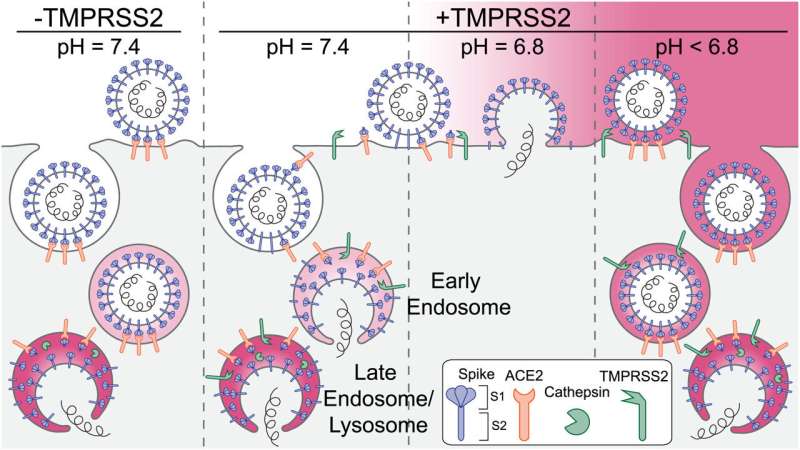Researchers capture live footage of virus infecting cell

In a first, scientists have captured on video all the steps a virus follows as it enters and infects a living cell in real time and in three dimensions.
Scientists achieved the feat by using advanced imaging called lattice light sheet microscopy as well as chemical and genetic manipulation.
The first part of the video shown here follows a virus engineered to sprout SARS-CoV-2 spike proteins (labeled pink) as it is captured at a cell surface and engulfed by a cellular compartment called an endosome. The virus then fuses with the endosome membrane and injects its genetic material (labeled blue) inside the cell—the steps necessary to kick off a cycle of viral infection and replication.
The second part of the video shows many such viruses inside the cell. The video covers 4 minutes of activity, with snapshots taken every 4 seconds.
The findings, published Sept. 1 in PNAS, provide new insights into the fundamental mechanics of viral infection and could point the way to new methods for intervening before the onset of COVID-19.
The researchers' work reveals that viruses can't fuse with the membrane and release their genomes unless they're bathed in a slightly acidic environment. Experiments indicated that the pH must fall between 6.2 and 6.8, just shy of neutral and on par with bodily fluids such as saliva and urine. Endosomes have such acidity, and the team's measurements confirmed that this is also the pH range inside a typical human nose, where SARS-CoV-2 infection often begins.
"Amusingly enough, measuring the pH of the nostril cavity has rarely been done before," noted co-senior author Tomas Kirchhausen, professor of cell biology in the Blavatnik Institute at Harvard Medical School and HMS professor of pediatrics at Boston Children's Hospital.
The acidic environment allows enzymes in the endosome or on the cell surface—including TMPRSS2, a key enabler of SARS-CoV-2 infection—to cut the spike protein and facilitate membrane fusion, the team found.
The work was led by the labs of Kirchhausen; former HMS professor Sean Whelan, now at Washington University in St. Louis; and Giuseppe Balistreri at the University of Helsinki. Alex Kreutzberger, HMS instructor in pediatrics in the Kirchhausen lab, is first author of the paper.Powerful new antibody neutralizes all known SARS-CoV-2 variants
More information: Alex J. B. Kreutzberger et al, SARS-CoV-2 requires acidic pH to infect cells, Proceedings of the National Academy of Sciences (2022). DOI: 10.1073/pnas.2209514119
Journal information: Proceedings of the National Academy of Sciences
Provided by Harvard Medical School
No comments:
Post a Comment